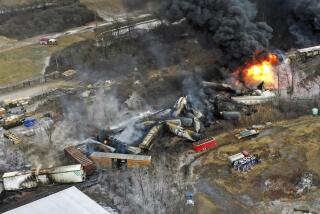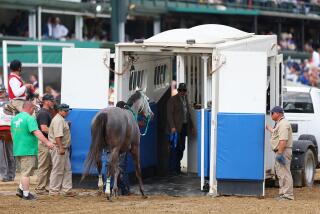Rail workers’ health issues are a growing safety concern
- Share via
Visibility was 10 miles and the morning sun had pushed the temperature close to 90 as Danny Joe Hall guided his mile-long Union Pacific freight train east through the grasslands of the Oklahoma Panhandle.
Near the farming town of Goodwell, federal investigators said, the 56-year-old engineer sped through a series of yellow and red signals warning him to slow down and stop for a Los Angeles-bound train moving slowly onto a side track.
The 83-mph collision killed Hall and two crewmen. Dozens of freight cars derailed, and the resulting inferno sent towers of black smoke over the plains, prompting the evacuation of a nearby trailer park.
As it turned out, Hall was colorblind.
The National Transportation Safety Board’s subsequent probe of the June 2012 wreck faulted the engineer’s deteriorating eyesight and inadequate medical screening that failed to fully evaluate his vision problems.
But the Goodwell crash underscored a far larger concern: Railroads are the only mode of U.S. commercial transportation without national requirements for thorough, regular health screenings to identify worker ailments and medications that could compromise public safety.
Crash investigations have linked train accidents to railway workers’ health problems. The Goodwell crash and a rear-end collision in Iowa in 2011 that killed an engineer and conductor are among those that authorities believe could have been prevented with more rigorous medical testing of train crews.
Federal investigators are examining whether an engineer’s severe case of undiagnosed sleep apnea — a condition that can cause fatigue — contributed to last year’s derailment of a New York commuter train that killed four passengers and injured 59. Union and legal representatives of the engineer have said he either nodded off or went into a daze before heading into a 30-mph curve at 82 mph.
The NTSB found that the engineer’s doctors never evaluated him for the condition, and medical guidelines provided to employees by the Metro-North Railroad did not mention sleep disorders.
“The problems are not getting fixed, and more significant risks could occur as the population of railroad workers ages,” said Mark Rosekind, an NTSB board member.
In contrast, airline pilots, truckers, bus drivers and maritime professionals must undergo medical examinations with stricter requirements annually or every few years. In those industries, more frequent evaluations are required for workers over 40 or who have chronic medical conditions that can worsen.
Severe allergies, heart disease, poor vision, sleep disorders and diabetes — as well as use of medicines with serious side effects — are among the health issues that can disqualify workers if the conditions can’t be adequately controlled.
Since 1988, the NTSB has pushed unsuccessfully for similar standards for more than 100,000 locomotive engineers, conductors and other railway workers. But the Federal Railroad Administration, which oversees the industry, has balked at imposing mandatory, comprehensive medical requirements.
Working with unions and carriers, the FRA has opted for non-mandatory education programs for rail workers, formal advisory notices and other strategies to reduce risks associated with health problems.
“The FRA is committed to ensuring that train operators are fit for duty,” said agency spokesman Kevin F. Thompson. The administration “continues to work with labor and industry to comprehensively address standardized medical practices.”
Currently, engineers and conductors are required to pass vision and hearing tests every three years. In a statement, Union Pacific, which employed the engineer faulted by the NTSB in the Goodwell crash, said it complies fully with current federal standards. Train crews also undergo random testing for alcohol and illegal drug use.
Railroads typically require physical exams when someone is offered a job, as well as after an extended medical leave or when an employee’s health is questioned at work. In addition, railroad medical departments offer wellness programs.
Some rail carriers, either on their own or after NTSB crash investigations, have voluntarily adopted measures that exceed federal standards, including obtaining medical histories of employees and educating workers about sleep disorders and medications. Amtrak, for example, requires annual medical examinations for engineers.
The FRA’s Thompson said current regulations and voluntary industry screening programs have contributed to a steady decline in railroad accidents. The last two years have been among the safest for the industry, and Thompson noted that no fatal train wrecks linked to the health problems of train operators occurred between 2002 and 2010.
However, NTSB officials, safety experts and former FRA officials say there is ample evidence that current practices, which put much of the onus to disclose serious medical problems on workers, need to be strengthened.
Dozens of crashes ranging from deadly collisions to less serious mishaps have been linked to sleep disorders, mental illness, poor vision and medications that can cause drowsiness, FRA and NTSB records show. Accidents have likewise been tied to a host of other maladies such as obesity, diabetes and cardiovascular diseases.
In 2001, a Canadian National Railway train ran a stop signal outside Clarkston, Mich., and rammed into an Illinois Central Railway train, killing its crew. NTSB investigators concluded that the Canadian railway engineer and conductor were fatigued because of sleep apnea. Doctors had told both men they had the condition, but neither obtained adequate treatment, the investigators concluded.
Three years ago, a Burlington Northern Santa Fe coal train whose two crew members had fallen asleep rear-ended a BNSF track maintenance train outside Red Oak, Iowa. The coal train’s crewmen were killed. Both were found to have serious medical problems, including obesity, high blood pressure, depression and diabetes, for which they were taking medications that officials say may cause drowsiness.
The full extent to which medical problems contribute to accidents is difficult to determine. Federal crash reports don’t always state an underlying cause; and NTSB investigators, who examine the medical conditions and histories of train crews after accidents, typically probe only the most serious incidents.
Because of data-gathering shortcomings “medical impairments are probably responsible for more accidents than the reports reflect,” said Bruce Fine, a former FRA associate administrator for safety.
NTSB investigations alone have linked medical problems to 13 serious train accidents since 1984. FRA data show that over the last three decades, some physical condition of a worker was a factor in at least 86 accidents that killed nine people and injured 61.
Almost three-quarters of those accidents involved employee fatigue, although the records do not indicate if sleep disorders or potentially sedating medications contributed to the fatigue.
One FRA analysis found that of 36 on-duty deaths of railway workers in 2003, 20 were a result of medical problems, primarily heart attacks. All of the workers involved were older than 47, raising fears among regulators about the potential safety risks of aging train crews. Most of the rail labor force is now over 45.
Despite such concerns, reform has been slow. After the 2001 Canadian railway crash was linked to sleep disorders, the FRA ramped up education programs, issued safety advisories and launched a study concluding that industrywide medical standards were needed and probably could have prevented past accidents.
The 2005 FRA report noted that at one of the nation’s largest railroads only 1% of workers had enrolled in a voluntary training course on sleep disorders.
Progress on new regulations, however, ran head-on into union and management concerns about the potential effects on rail operations and on the privacy of workers’ health records.
“Does a railroad really need to know if I take Lipitor or other prescriptions?” said James A. Stem Jr., the national legislative director for the United Transportation Union.
William C. Keppen, a Maryland-based transportation safety consultant, said one solution could be the use of independent medical examiners to determine if rail employees are fit to work but who withhold specific findings from employers, a system used for pilots.
By 2012, the attempt to draft comprehensive requirements collapsed. Medical professionals, union officials and industry representatives couldn’t agree on how to proceed, according to FRA officials and NTSB records. FRA officials also said the proposals would be too expensive for carriers, although a cost-benefit analysis was not performed.
“It was not a trivial amount of money for the railroads,” said Grady C. Cothen Jr., who headed the FRA’s regulatory program before retiring in 2010. But industrywide regulations “could have worked with FRA oversight.”
Shortly after the effort stalled, the Goodwell crash occurred and the NTSB renewed its recommendations for comprehensive medical requirements.
FRA officials promised to reconsider vision and hearing standards, revisit the issue of sleep disorders and explore other voluntary measures. In February, the NTSB called that approach “unacceptable.”
More to Read
Sign up for Essential California
The most important California stories and recommendations in your inbox every morning.
You may occasionally receive promotional content from the Los Angeles Times.














